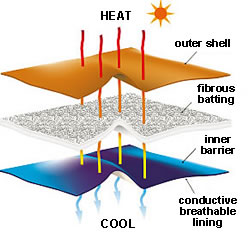|
Hydroweave® - How It Works
 In
today's market, there are several different types of
cooling options that are available for portable body
cooling. The most sophisticated of these are essentially
portable, tethered air conditioners that have been developed
for military use, particularly explosive ordinance disposal
personnel and astronauts. As one would expect, these
systems are not only heavy, but are also extremely expensive.
Furthermore, as with any system, there is the tradeoff
between cooling effect and the burden on the individual
by adding weight. Other systems relying on fluid flow
include recirculating vests using pumps and motors;
these also suffer from severe weight penalties and are
generally not user friendly. In
today's market, there are several different types of
cooling options that are available for portable body
cooling. The most sophisticated of these are essentially
portable, tethered air conditioners that have been developed
for military use, particularly explosive ordinance disposal
personnel and astronauts. As one would expect, these
systems are not only heavy, but are also extremely expensive.
Furthermore, as with any system, there is the tradeoff
between cooling effect and the burden on the individual
by adding weight. Other systems relying on fluid flow
include recirculating vests using pumps and motors;
these also suffer from severe weight penalties and are
generally not user friendly.
Probably the most common cooling garments, (vests) are
those that rely on ice packs which are inserted into
various pockets built into the vest. These systems tend
to be heavier and also offer limited cooling effect
when compared to the BodyTeq products. Ice packs are
bulky and the fact that they are placed at specific
body areas means that cooling is only provided to those
locations where the pockets are located. Additionally,
this style of design makes it more difficult to configure
the garment for full body applications, and non-uniform
body cooling can present false impressions to the wearer
about his or her true physiological state; e.g., core
body temperature is rising even though he or she feels
cool.
Since BodyTeq products do not rely on bulky, localized
cooling areas, the weight penalty is minimal and works
out to be much less than a similarly designed ice pack
vest. BodyTeq products must be soaked in water before
use, while icepacks must be kept in a freezer before
use. Typically, it is much easier to soak the garment
than it is to have ready access to a freezer.
The effectiveness of the garment is based on its ability
to absorb heat from the body and release that heat to
the outside environment. The water that is absorbed
by the batting material provides a heat transfer medium
for this effect. As the heat accumulates in the material,
the heat causes the water to evaporate from the vest.
The direction of this heat is to the outside because
the moisture differential is less to the outside (the
environment next to the body is generally at a high
relative humidity). Thus, the garment provides both
evaporative cooling and conduction, the two principal
means of body cooling.
The length and magnitude of this cooling effect will
depend upon several factors:
-
The activity level of the wearer
-
The temperature and relative humidity of the environment
-
The physical condition of the wearer
-
The type and configuration of other clothing being
worn
As might be expected, higher activity levels will reduce
the effective cooling time. Similar effects will be
experienced with relatively high temperatures and relative
humidity. In addition, the greater the surface area
of the body covered and in contact with Hydroweave®
fabric, a more substantial cooling effect will result.
Cooling effects may be diminished if insultated underclothing
is worn to limit contact of the vest with the wearer's
skin, or if barrier clothing is worn over the vest,
creating a microenvironment immediately outside the
vest.
Use of these garments is limited to warm-to-hot conditions,
or where activity is high during moderate temperature
environments. Use of these garments is not advisable
during cool weather operations because heat will be
transferred from the body to the garment making the
wearer feel uncomfortably cool.
Some concerns have arisen that Hydroweave® can act
as a heat sink under certain environmental conditions,
i.e., once it has absorbed heat from the body in a warm
environment, then continued wearing could result in
heat transfer back to the body as the garment's cooling
ability is depleted. This phenomena should not be a
concern because as explained above, the driving force
is away from the body. The microenvironment between
the body and the vest is generally at high humidity,
therefore the evaporative heat is released away from
the body as water evaporates from the BodyTeq product.
In addition, any system (including ice pack technology)
will have its effectiveness diminished over time where
the transfer of heat away from the body is lessened
as the material reaches its heat storage capacity. For
example, as the icepacks absorb heat, they obviously
reach ambient temperature. The same is true for BodyTeq
products, but the key difference between the delivery
systems is that while ice packs rely on conductive cooling
only, BodyTeq products made with Hydroweave® use
the two forms of heat transfer for achieving their cooling
effect.
Finally, it must be remembered that a person who is
sweating will already be generating water that is absorbed
into conventional clothing or stays on the surface of
the skin. Since the BodyTeq product is already providing
cooling, it is preventing much of the body sweating
that normally occurs and uses the material instead to
transfer heat via evaporation of the water in the material.
Evaporative
Cooling Discussion
<<
back
|
